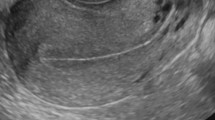Abstract
Pelvic ultrasonographic (US) studies of four patients (ages 11–19 years) with Turner's syndrome, 45,X karyotype, and normal ovarian function were reviewed. All four had persistent menses, spontaneous breast development, and normal follicular stimulant hormone (FSH) serum concentrations. The US studies depicted normal postpubertal uterus and normal-sized ovaries with follicles. In three patients, ovaries were seen bilaterally, while in one only one gonad was identified. Radiologists should be aware that patients with Turner's syndrome, even with a single X chromosome, may occasionally have normal genital development.
Similar content being viewed by others
References
Turner HH (1938) A syndrome of infantilism, congenital webbed neck, and cubitus valgus. Endocrinology 23: 566–574
Behrman RE (1992) Chapter 19.34: The endocrine system: disorders of the gonads, pp 1236–1237 In: Kliegman RM, Nelson WE (eds) Nelson Textbook of Pediatrics, 14th edn. W. B. Saunders Company, Philadelphia, pp 1460–1462
Hook EB, Warburton D (1983) The distribution of chromosomal genotypes associated with Turner's syndrome: livebirth prevalence rates and evidence for diminished fetal mortality and severity in genotypes associated with structural X abnormalities or mosaicism. Hum Genet 64: 24–27
Massarano AA, Adams JA, Preece MA, et al (1989) Ovarian ultrasound appearances in Turner syndrome. J Pediatr 114: 568
Federman DD (1987) Mapping the Xchromosome: minding its p's and q's (editorial). N Engl J Med 317: 161–162
Weiss L (1971) Additional evidence of gradual loss of germ cells in the pathogenesis of streak ovaries in Turner's syndrome. J Med Genet 8: 540–544
Page LA, Beauregard LJ, Bode HH, Beitins IZ (1990) Hypothalamic-pituitary-ovarian function in menstruating women with Turner syndrome (45,X). Pediatr Res 28: 514–517
Singh RP, Carr DH (1966) The anatomy and histology of XO human embryos and fetuses. Anat Rec 155: 369–384
Carr DH, Haggar RA, Hart AG (1968) Germ cells in the ovaries of XO female infants. Am J Clin Pathol 49: 521–526
Baker TG (1963) A quantitative and cytological study of germ cells in human ovaries. Proc R Soc Lond [Biol] 158: 417–433
Shawker TH, Garra BS, Loriauz DL, Cutler GB, Ross JL (1986) Ultrasonography of Turner's syndrome. J Ultrasound Med 5: 125–129
Parks JE, Ruffing NA (1992) Factors affecting low-temperature survival of mammalian oocytes. Theriogenology 37: 59–73
Author information
Authors and Affiliations
Rights and permissions
About this article
Cite this article
Boechat, M.I., Westra, S.J. & Lippe, B. Normal US appearance of ovaries and uterus in four patients with Turner's syndrome and 45,X karyotype. Pediatr Radiol 26, 37–39 (1996). https://doi.org/10.1007/BF01403702
Received:
Accepted:
Issue Date:
DOI: https://doi.org/10.1007/BF01403702




